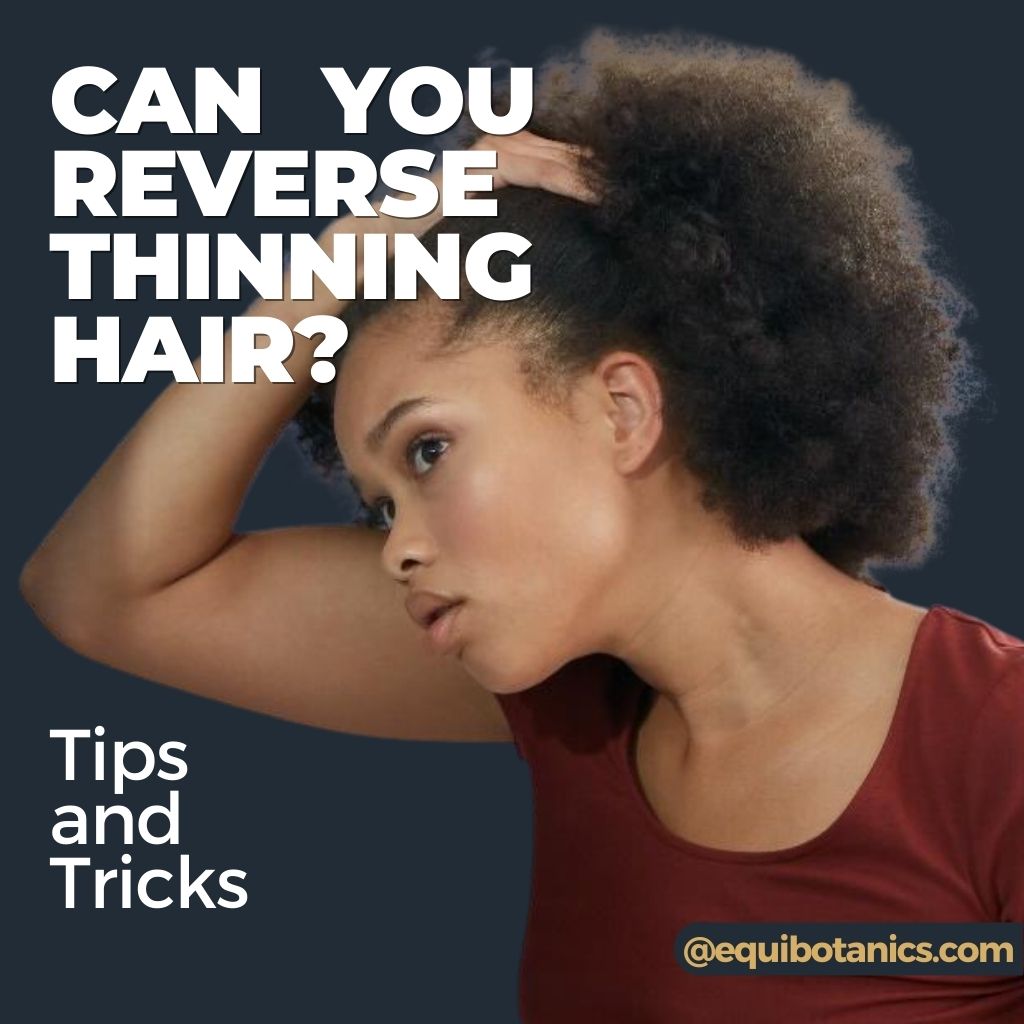
Hair loss is a condition that affects many people, and it can be distressing for those who experience it. Shedding hair is a normal part of the hair growing cycle and we can lose anywhere between 50-100 hairs a day. If you’re losing more than this, however, then you may notice your hair is thinning.
Although hair loss isn’t curable as such, it is treatable and there are various methods that can be undertaken to encourage re-growth and prevent further loss. Read on as we share our top tips on how you can reverse hair thinning.
Key Summary
- Thinning hair cannot be cured but there are natural and medicinal methods that can treat the effects to encourage regrowth.
- Illness, stress, vitamin deficiencies, and harsh hair care products can all contribute to thinning hair.
- Using stimulating hair oils, scalp massages, a nutrient rich diet, and laser therapy can all help to promote regrowth.
How to Tell if Your Hair is Thinning?
When hair thinning is gradual, you may be unsure as to whether you are suffering with actual hair loss. If you’re wondering what thinning hair looks like, some signs you may notice include:
- Hair thinning at the crown
- Female hair thinning at the temples
- Male diffuse thinning, which is where hair falls from all areas of the scalp
- More hair on your clothes or in the shower
- Circular, patchy areas
Why is My Hair Falling Out? Main Causes

Thinning hair can be caused by various factors including health, the ageing process, and even your lifestyle. To understand how to reverse thinning hair, it’s important to identify the cause. Some reasons you may be suffering with hair loss and thinning include:
Stress
Stress or trauma can trigger telogen effluvium which is where your hair follicles enter a longer resting period than usual, meaning shed hair isn’t replaced as quickly. If your hair is thinner on one side, this may be because of a specific trauma to that side of the head which has sparked a temporary period of hair loss.
Illness
Certain illnesses, such as thyroid disorders or autoimmune diseases, can cause hair loss and thinning as they place the body under strain.
Alopecia areata is a hair loss illness where the immune system attacks the hair follicles, leading to extreme hair fall. This condition commonly presents itself in patchy hair which can grow larger over time.
As well as illness itself, some medications or treatments can cause hair loss, including beta-blockers, blood thinners, antidepressants and chemotherapy.
Lack of Vitamins
Vitamins and nutrients play an important role in hair health and growth. When deficient in certain vitamins and minerals such as iron, vitamin B or protein, this may be contributing to your hair thinning, as these nutrients are used to support cells used for hair growth.
If you’ve noticed hair loss on the temples – whether you’re male or female – then this can signal a lack of protein in your diet.
Genetics

Androgenetic alopecia is a genetic condition that occurs in both men and women, and it’s more commonly known as female or male pattern baldness. In men, hair sheds from above both temples to create an “M” shape hairline over time.
For women, the hairline tends to stay intact, and it is more general shedding with noticeable crown thinning, as well as loss along the parting. Females may also notice hair thinning at the temples.
Tight Hairstyles
Tight ponytails or buns and protective styling, such as cornrows or braids, can cause tension resulting in traction alopecia. The stress of these hair styles on the hair follicles cause damage that can occasionally be permanent.
Overtreated Hair
Regular colouring of hair, as well as perms and chemical straightening, can cause dry, dehydrated locks that can be more susceptible to breakage. Regular use of strong chemical treatments can also affect scalp health which can discourage growth and cause hair loss.
Harsh Hair Products
For those using hair sprays, extreme hold gels or even chemically-formulated shampoos, especially those with sulphates, hair loss could be related to their usage. Their harsh ingredients strip hair of essential moisture and can cause damage to the scalp and follicles which prevents growth and sees hair thinning as a result.
Hormonal Changes
A common cause of thin hair in women is hormonal changes. Changes such as the menopause or pregnancy, can cause hair loss and thinning due to a fluctuation in oestrogen and progesterone, which can cause hair follicles to shrink.
Treatments for Thinning Hair

There are a variety of methods that can be used to help reduce hair loss and encourage regrowth. Hair regrowth can be seen in as little as 3 weeks, but don’t expect to see a full head of hair by then! Growing your locks after thinning and loss requires both patience and consistency.
By 12 weeks, you can expect to see some more significant progress on your hair growth journey. Our tips and tricks for hair regrowth are:
1. Reduce Stress
It may be easier said than done when experiencing thinning hair, but getting your stress levels under control is a great way to ease excessive shedding. The stress hormone, cortisol, that’s released from the adrenal glands can upset the hair growth cycle resulting in loss.
Take time out to relax, be that with a pamper evening or a round of golf, whatever hobby you choose will help to alleviate stress which, in turn, could reduce your hair loss.
Pros
- Reducing stress will lower your cortisol levels that can cause hair loss
Cons
- Won’t cure medical conditions that cause hair loss
2. Scalp Massage
An easy and affordable way to encourage hair regrowth is to introduce a daily massage into your routine. This simple hair thickening treatment only requires five minutes of your time a day to take effect.
Performing a regular, stimulating head massage will encourage circulation to the scalp that is needed for hair growth as well as removing dead skin cells that can clog the follicles. On hair wash days, use an oil prior to stepping into the shower and carry out a longer massage.
Pros
- Helps to relieve stress
- Stimulates circulation and encourages blood flow to the scalp
Cons
- Won’t solve the cause of the hair loss
3. Change Hair Care Products
Look for gentle formulations when it comes to styling and hair wash products, and wherever possible switch to those that are naturally-derived.
We would also recommend introducing a nourishing hair mask, such as the Babassu Deep Treatment Hair Masque, once a week.
Babassu Oil Treatment Hair Masque
The Babassu Deep Treatment Hair Masque is an intensive protein-moisture balanced treatment that applies a restorative formula to the hair, using steam to encourage absorption into the hair shaft. It is jam-packed with Brazilian butter, Tucuma and Murumuru seed butters and revitalising oils to nourish your hair. It’s so rich and gets to work for longer, you only need to apply it once or twice a month.
Packed full of hydrating oils, as well as proteins and fatty acids, this mask will help to restore the condition of your hair. Using a hair mask will also work to keep hair well protected during the regrowth process.
Pros
- Hair masks help to support hair growth through rehydrating locks
Cons
- Can be hard to find naturally-formulated styling products
4. Hair Washing Routine
It’s important not to shy away from washing your locks if you are experiencing thinning hair and fall out. And if you are wondering how often to wash thinning hair, the answer is as and when it is needed, just the same as normal hair, although we would recommend no more than three times a week to avoid stripping hair of its crucial natural oils.
Although it can seem like more strands fall out in the shower, the water is simply washing out those that were already loose. Choose a sulphate free shampoo, such as the Baobab Cleanser & Detangler, to gently cleanse locks whilst keeping them hydrated to promote growth.
Baobab Hair Detangler & Cleanser
We prefer to avoid calling this a detangling shampoo. Instead, we call ours a detangling cleanser because it’s softening and moisturising while cleansing thoroughly. It also acts as your pre-poo detangler before you wash. Are you tired of that stripped feeling after you’ve just washed your hair? Wash your hair not strip it of its natural oils.
It is also important to use conditioner with every hair wash as this can help to support the hair cuticles and keep hair moisturised, preventing valuable regrowth from breaking.
Pros
- Naturally-derived formulas are kinder on the scalp
- Supports hydration
Cons
- Hair washing won’t tackle thinning hair on its own
5. Dietary Changes
Eating a balanced diet can help to support hair health, particularly if you’re currently missing out on foods rich in vitamins and nutrients that help encourage hair growth. Look for foods that are high in the following vitamins for thinning hair:
Protein: found in chicken and nuts, protein helps to form the hair follicles which hold hair at the root and helps it grow.
Iron: eat plenty of spinach to increase your iron intake. This nutrient carries oxygen to the cells that help hair grow.
Vitamin B7: known as biotin, this vitamin aids keratin production and raises the follicle growth rate to promote growth and reduce loss.
Omega-3 fatty acids: found in salmon and nuts, omega-3 can reduce inflammation around hair follicles that could be reducing growth rate.
Pros
- Increasing vitamin and nutrient intake will encourage hair growth
Cons
- Some diet choices, such as veganism, can limit vitamin and nutrient intake resulting in further hair loss
6. Supplements
As well as making changes to your diet, you could introduce a supplement or multivitamin to support healthy growth and discourage loss. When you are lacking in certain vitamins, follicles can fail to produce new hair, leaving your locks feeling sparse.
Using a hair specific supplement will give you peace of mind that you are getting the right dose of vitamins and minerals to help thicken your thinning locks.
Pros
- Easy to purchase supplements from local chemist or supermarket
Cons
- Excess nutrients can be harmful
7. Medication

With severe hair loss and thinning, you may wish to speak to a medical professional who can provide a diagnosis and, in some cases, issue a prescription medication.
There are several types of medication used to treat hair loss, these include:
Minoxidil: this is a liquid that is applied directly to the scalp twice a day. It can be used to treat both female and male pattern baldness and works to thicken hair in areas, such as for crown hair loss, but must be used consistently to see results.
Finasteride: this can be used to treat male pattern baldness but cannot be used by women. It is a daily pill that has been shown to be effective in reducing hair loss in men.
Pros
- Finasteride is an easy-to-take, daily pill
Cons
- Minoxidil can cause scalp irritation
- They can take as long as 16 weeks to see improvement
8. Cosmetic Therapies
There are some alternative, cosmetic treatments available that can help with hair loss including laser therapy and PRP therapy.
Laser therapy, also known as red light therapy, exposes the scalp to a low-level laser that increases blood flow to the scalp which supports the hair follicles. The photons in the laser get absorbed by weakened scalp cells to encourage growth. There are also at-home laser therapy products available to buy.
Platelet-rich plasma therapy (PRP) is a medical process where blood is taken, processed, and re-injected back into the scalp. This encourages follicle hair growth through stimulating inactive hair cells and pushing them back into a growth stage.
Pros
- Laser therapy can be carried out at home
- No risk of rejection as you use your own blood in PRP therapy
Cons
- Both are expensive
- Progress can be slow
9. Hair Oils
Hair oils are an important tool for hair loss and thinning as they provide essential moisture to the scalp which supports growth.
Oils such as jojoba, marula, argan, or black seed are all known to have stimulating qualities. Use a product, such as the Black Seed Oil Hair Elixir, which is particularly effective at achieving growth around stubborn areas such as the temples and hairline, whilst keeping hair nourished to prevent breakages.
Black Seed Hair Oil Elixir
This Black Seed Oil For Hair is enriched with Fenugreek, Brahmi and Bhringaraj ayurvedic oils, our first hair serum is your best bet to reaching your hair goals. Stop split ends, check. Stop itchy scalp, check. Help accelerate growth, check check check. We've jam-packed this little bottle with luxurious ingredients from the Caribbean, India and the Amazonian rainforest to give you longer, thicker, and stronger hair in less time.
You could also use essential oils, such as peppermint, rosemary, or lavender, which have been shown to have properties that are successful in pattern baldness regrowth. You cannot use neat essential oils on the skin as they are highly concentrated. Mix a few drops into a carrier oil, for example almond, or into a shampoo before applying.
Pros
- Natural way to treat hair loss
Cons
- Not suitable for those with sensitive skin
- Can cause allergic reactions
Summary
When it comes to thinning hair vs normal hair, of course, there will be some major differences in the feel and appearance but, with some consistent use of our listed remedies, you can correct hair thinning with some small amounts of regrowth progress being seen relatively quickly.
It is important to identify the underlying cause before treating the problem. Remain patient and realistic throughout your journey, and you’ll find that you can grow hair back after thinning!


